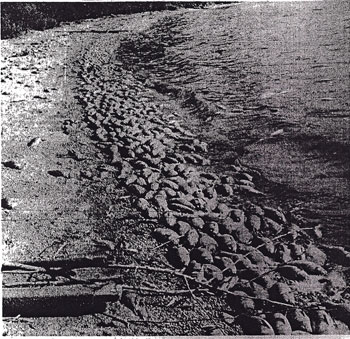Editor’s note: Faced with evidence that Asian carp have managed to find their way past an electrical barrier, earlier this month Gov. Jennifer Granholm called for aggressive action to prevent the fish from entering the Great Lakes: “In the meantime, we must use every available tool at our disposal to protect the Great Lakes, including closing the locks, expanding eDNA testing and applying additional rotenone as necessary.”
This week, The Chronicle’s local history columnist Laura Bien takes a 40-year look back into the past at the use of rotenone on a local lake – Ford Lake. That body of water received a passing mention in Matt Naud’s environmental indicator column on phosphorus – it involved a 1991 algal bloom. But back in the early 1970s Ford Lake wasn’t blooming algae, it was blooming fish.

Shoreline of Ford Lake after the fish kill.
In 1973, the Michigan Department of Natural Resources wanted to turn Ypsilanti’s Ford Lake into a fisherman’s paradise. They planned to stock it with muskellunge, rainbow trout, and large- and smallmouth bass.
The only problem was the lake’s population of “rough fish” – mostly the common carp, plus bullheads and suckers. Carp are not native to Michigan. They were introduced in the late 19th century by the era-equivalent of the DNR as a valuable food fish that was cheap to keep on artificial ponds dug on farmers’ land. The farmers’ aquaculture projects inevitably spilled into Michigan waterways.
A century later, the DNR planned to douse Ford Lake with the piscicide rotenone to kill the carp and other rough fish, then whisk the remains into the Ypsilanti Township landfill and restock the pond.
Instead, the project led to a statewide ban on rotenone. [Full Story]




